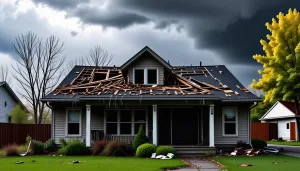Evaluating the condition of your roof is the foundational step in determining whether you need a repair or a full replacement. A thorough assessment involves examining several key indicators that can help you understand the current state of your roofing situation and guide your decision on repair vs replacement.
Begin by looking for visible signs of damage. Roof shingles that are cracked, curled, or missing are often the first indicators of potential problems. If you notice any of these signs, it may suggest the need for repairs to prevent further deterioration. Additionally, check for any sagging or uneven areas, as these could point to structural issues beneath the roofing materials.
Another critical factor to consider is water damage. Water stains on the ceiling of your home or damp areas in the attic are symptoms of leaks, which can lead to more significant issues if not addressed promptly. Inspect these areas closely, as persistent leaks can compromise the integrity of the roof and necessitate a complete replacement rather than just simple repairs.
Take note of any granule loss from asphalt shingles, which can be observed by checking gutters or areas around the downspouts. Granule loss accelerates shingle deterioration and reduces the roof’s ability to protect your home. In contrast, if your roof is covered with cedar shakes, look for signs of moss or rot, and for metal roofs, check for rust spots or loose fasteners.
It’s also wise to consider the age of your roof. Typical asphalt shingle roofs have a lifespan of around 20 to 25 years, while metal and tile materials can last upwards of 50 years. If your roof is approaching the end of its expected life cycle, a full replacement might be more cost-effective in the long run compared to frequent, temporary repairs.
| Indicators | Risk Level | Recommendations |
| Cracked or missing shingles | Moderate | Consider repair if isolated; replacement if extensive |
| Water stains inside home | High | Immediate repair; evaluate for possible replacement |
| Sagging areas | Critical | Immediate structural assessment; likely replacement needed |
| Granule loss in shingles | Moderate | Repair if minor and shingle life is still long |
Conducting a detailed inspection or hiring a professional roofing contractor is essential to correctly evaluate these signs and determine the best course of action. A professional can provide an unbiased assessment and recommend whether a repair or replacement would be most appropriate based on the current condition and type of roofing materials involved.
cost considerations for roof repair
When considering the cost of roof repair, it’s important to weigh several variables that can influence the total expense. These considerations will help guide you in determining whether a repair is financially viable compared to a complete replacement.
1. Extent of Damage:
– Small Areas: If the damage is localized, such as a few missing shingles after a storm, the repair costs are typically lower. In such cases, the repair vs replacement debate often leans towards repair due to the minimal area affected.
– Widespread Issues: Extensive damage across larger sections of the roof, like pervasive leaks or significant granule loss, will naturally increase repair costs, narrowing the cost differential with a full replacement.
2. Type of Roofing Material:
– Asphalt Shingles: These are generally the least expensive to repair. The cost is largely driven by the price per square foot, with variations based on shingle quality and brand.
– Metal or Tile Roofs: Repairs for these materials tend to be more costly due to the complexity of the work involved and specialized skills required for proper repair.
– Cedar Shakes: Involves higher repair costs than asphalt shingles because of the materials and labor-intensive installation process.
3. Labor Costs:
– Labor is a significant portion of roof repair expenses. Rates can vary depending on geographic location and the expertise required for the specific type of roofing material.
4. Permit Fees and Regulations:
– In some municipalities, particularly those prone to strict housing codes, permit fees could add to the overall repair cost. Ensure to verify local regulations and necessary permits before proceeding.
5. Accessibility of the Roof:
– The ease with which workers can access the affected areas can impact the repair costs. Roofs with steep pitches or complicated structures may incur higher labor fees due to safety measures and additional time required.
6. Emergency Repairs:
– Urgent repairs, especially after severe weather events, often cost more as contractors may charge a premium for priority service or work outside regular business hours.
7. Warranty and Guarantees:
– Some roofing companies offer warranty services or guarantees on their repair work, which can influence the initial repair cost. While potentially raising the upfront cost, warranties provide peace of mind and can protect against future expenses.
Considering these cost factors is essential in determining the most financially sound decision between repair and replacement. Often, investments in minor repairs can delay the need for a full replacement and extend the life of your existing roof, making this option more appealing when budget constraints are at play. However, if the recurring costs of maintenance accumulate or the roof’s lifespan is nearing its end, replacement might be the more economical choice in the long run.
evaluating roof replacement expenses
When contemplating roof replacement, understanding the varying expenses involved is critical in making an informed decision. The cost of a full roof replacement can significantly differ based on several key factors, each contributing to the overall financial picture and influencing the repair vs replacement debate.
1. Size and Scope of the Project:
The size of your roof is a primary determinant of replacement costs. Larger roofs require more materials and labor, naturally increasing the total expense. It’s important to accurately measure the roof’s square footage to obtain precise estimates. Additionally, any architectural complexities, such as chimneys, skylights, or intricate designs, can add to the cost due to the increased labor and possibly specialized roofing materials required.
2. Choice of Roofing Material:
The type of roofing material you select greatly impacts the expense of a roof replacement. Asphalt shingles remain the most economical option, balancing cost with durability. However, materials such as metal, tile, or slate, although more expensive initially, offer superior longevity and aesthetic appeal. Each material choice varies in cost per square foot, and opting for higher-end options can significantly elevate the cost, though potentially offering longer-term savings on maintenance.
3. Removal of Old Roofing:
Before new materials can be installed, the old roof often needs to be stripped, especially if it’s severely damaged or if local building codes require it. The removal process itself can be labor-intensive and may add substantially to the overall cost. Additionally, if any hidden problems, like mold or structural deficiencies, are discovered during removal, these will need to be addressed, further influencing the budget.
4. Labor Costs and Contractor Expertise:
Labor costs constitute a significant portion of replacement expenses. Hiring experienced and reputable contractors is crucial to ensure quality work, though their rates might be higher. Expert roofers can efficiently handle diverse materials and complex installations, reducing the chances of future issues that could arise from subpar workmanship.
5. Geographic Location and Climate Considerations:
The location of your home can affect the cost of a roof replacement. Prices vary by region due to differences in local labor rates and the availability of materials. Moreover, climatic conditions are a significant consideration; areas prone to harsh weather may require specific materials or additional protective measures, escalating costs.
6. Permits and Compliance with Local Building Codes:
Acquiring the necessary permits is often a non-negotiable step in the roof replacement process, and fees vary by municipality. Compliance with local codes is mandatory and might necessitate additional work, such as upgrading insulation or ventilation, impacting the total cost. Ensuring all regulatory requirements are met prevents future legal complications and is crucial for the project’s legitimacy.
Evaluating these expenses thoroughly provides a clearer picture of what to expect when considering a roof replacement. While initially more costly than repairs, a full replacement can offer enhanced durability and potentially lower maintenance costs over time. By weighing the long-term benefits against the upfront investment, you can better determine when replacement might provide more value compared to short-term repair solutions, especially if you consider factors like increased property value and improved energy efficiency.
factors influencing the decision
When deciding whether to repair or replace your roof, several critical factors can influence your decision. First and foremost, the age of your existing roofing is a significant determinant. If your roof is nearing the end of its lifespan, opting for a replacement is often the wiser investment, even if current damages appear minor. This approach can save you from recurring repair costs and the risk of sudden failures when you least expect them.
The severity and frequency of damage also play a crucial role in the repair vs. replacement dilemma. Consider the extent and type of damage – isolated issues such as a few cracked shingles or a minor leak might be effectively addressed through repairs. However, widespread problems like significant water damage, sagging roof sections, or large areas with missing shingles might suggest that replacement is a more comprehensive and stable solution.
Consider the climate in your region when making this decision. Areas prone to severe weather conditions, such as heavy snowfall, intense heat, or frequent storms, demand a roofing solution that can withstand these elements over time. In such cases, replacement might offer longer-term resilience by providing enhanced structural integrity and weatherproof performance, minimizing the need for frequent repairs.
Energy efficiency is another consideration that can influence your decision. A new roofing installation can often be an opportunity to improve the energy efficiency of your home. Modern materials and technologies offer improved insulation and reflective properties that can result in significant savings on energy bills. The initial outlay for a replacement might be offset by these savings over time, making it a financially sound decision.
Additionally, personal priorities, such as aesthetics and property value, can weigh heavily on this decision. If you’re planning to sell your home in the near future, installing new roofing might enhance its curb appeal and resale value, offering a return on investment that transcends the initial expense.
Consulting with professional roofing contractors can also provide valuable insights. They can help identify whether current issues are superficial by nature or indicative of underlying structural concerns, helping you to make an informed decision.
Ultimately, the choice between repair and replacement should be guided by a comprehensive evaluation of these factors. Weighing the cost implications, both short-term and long-term, while considering the structural needs of your home, will lead to a decision that balances immediate budget constraints with future peace of mind.
long-term financial implications
When considering the long-term financial implications of roof repair versus replacement, it’s essential to evaluate how each option aligns with your budget and future plans. A roofing repair, while potentially less expensive upfront, may lead to repeated expenses if the damage is extensive or if the roof is nearing the end of its lifespan. Such recurring repairs can accumulate considerable costs over time, possibly eclipsing the price of a one-time replacement. This is especially true if issues are fundamental or indicate underlying problems that may worsen, like structural damage or persistent leaks.
Conversely, opting for a complete roof replacement typically involves a substantial initial investment. However, this approach can be more cost-effective in the long run if it addresses the core issues effectively and offers a fresh, more robust covering that’s less prone to frequent damage. Moreover, a new roof can enhance your home’s energy efficiency, potentially reducing heating and cooling costs. Modern roofing materials are designed with advanced technologies that improve insulation and reflect heat more efficiently, translating into tangible savings on energy bills.
Investing in a new roof can also significantly impact your property’s market value. A well-maintained home with a new roof is more attractive to potential buyers, increasing its resale potential and helping to recover some of the replacement costs upon sale. In some cases, insurance premiums may be lower for homes with newer roofing, further reducing ongoing expenses and offering an additional financial incentive for considering a replacement over piecemeal repairs.
Finally, a new roof provides peace of mind, eliminating concerns over constant maintenance and unexpected failures during harsh weather conditions, which are invaluable for homeowners seeking stability and reliability. Evaluating these financial factors against your current circumstances and future homeownership plans will guide you to a decision that’s economically rational and aligned with your long-term goals.
In conclusion, when deciding between a roof repair and replacement, consider both the immediate costs and the potential long-term savings. A temporary fix might suffice for minor damage, but a full replacement could offer greater security and cost-efficiency over time by reducing recurring repair expenses and enhancing your home’s value and energy performance. Balancing these factors carefully will ensure a wise investment in your property’s future.





